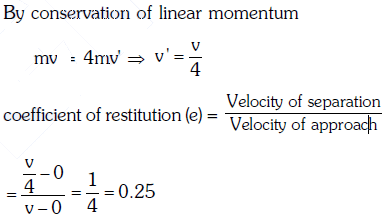NEET Exam > NEET Questions > A moving block having mass m, collides withan...
Start Learning for Free
A moving block having mass m, collides withanother stationary block having mass 4m. Thelighter block comes to rest after collision. When theinitial velocity of the lighter block is v, then the valueof coefficient of resistitution (e) will be :-
- a)0.5
- b)0.25
- c)0.8
- d)0.4
Correct answer is option 'B'. Can you explain this answer?
| FREE This question is part of | Download PDF Attempt this Test |
Verified Answer
A moving block having mass m, collides withanother stationary block ha...


|
Explore Courses for NEET exam
|

|
Similar NEET Doubts
A moving block having mass m, collides withanother stationary block having mass 4m. Thelighter block comes to rest after collision. When theinitial velocity of the lighter block is v, then the valueof coefficient of resistitution (e) will be :-a)0.5b)0.25c)0.8d)0.4Correct answer is option 'B'. Can you explain this answer?
Question Description
A moving block having mass m, collides withanother stationary block having mass 4m. Thelighter block comes to rest after collision. When theinitial velocity of the lighter block is v, then the valueof coefficient of resistitution (e) will be :-a)0.5b)0.25c)0.8d)0.4Correct answer is option 'B'. Can you explain this answer? for NEET 2024 is part of NEET preparation. The Question and answers have been prepared according to the NEET exam syllabus. Information about A moving block having mass m, collides withanother stationary block having mass 4m. Thelighter block comes to rest after collision. When theinitial velocity of the lighter block is v, then the valueof coefficient of resistitution (e) will be :-a)0.5b)0.25c)0.8d)0.4Correct answer is option 'B'. Can you explain this answer? covers all topics & solutions for NEET 2024 Exam. Find important definitions, questions, meanings, examples, exercises and tests below for A moving block having mass m, collides withanother stationary block having mass 4m. Thelighter block comes to rest after collision. When theinitial velocity of the lighter block is v, then the valueof coefficient of resistitution (e) will be :-a)0.5b)0.25c)0.8d)0.4Correct answer is option 'B'. Can you explain this answer?.
A moving block having mass m, collides withanother stationary block having mass 4m. Thelighter block comes to rest after collision. When theinitial velocity of the lighter block is v, then the valueof coefficient of resistitution (e) will be :-a)0.5b)0.25c)0.8d)0.4Correct answer is option 'B'. Can you explain this answer? for NEET 2024 is part of NEET preparation. The Question and answers have been prepared according to the NEET exam syllabus. Information about A moving block having mass m, collides withanother stationary block having mass 4m. Thelighter block comes to rest after collision. When theinitial velocity of the lighter block is v, then the valueof coefficient of resistitution (e) will be :-a)0.5b)0.25c)0.8d)0.4Correct answer is option 'B'. Can you explain this answer? covers all topics & solutions for NEET 2024 Exam. Find important definitions, questions, meanings, examples, exercises and tests below for A moving block having mass m, collides withanother stationary block having mass 4m. Thelighter block comes to rest after collision. When theinitial velocity of the lighter block is v, then the valueof coefficient of resistitution (e) will be :-a)0.5b)0.25c)0.8d)0.4Correct answer is option 'B'. Can you explain this answer?.
Solutions for A moving block having mass m, collides withanother stationary block having mass 4m. Thelighter block comes to rest after collision. When theinitial velocity of the lighter block is v, then the valueof coefficient of resistitution (e) will be :-a)0.5b)0.25c)0.8d)0.4Correct answer is option 'B'. Can you explain this answer? in English & in Hindi are available as part of our courses for NEET.
Download more important topics, notes, lectures and mock test series for NEET Exam by signing up for free.
Here you can find the meaning of A moving block having mass m, collides withanother stationary block having mass 4m. Thelighter block comes to rest after collision. When theinitial velocity of the lighter block is v, then the valueof coefficient of resistitution (e) will be :-a)0.5b)0.25c)0.8d)0.4Correct answer is option 'B'. Can you explain this answer? defined & explained in the simplest way possible. Besides giving the explanation of
A moving block having mass m, collides withanother stationary block having mass 4m. Thelighter block comes to rest after collision. When theinitial velocity of the lighter block is v, then the valueof coefficient of resistitution (e) will be :-a)0.5b)0.25c)0.8d)0.4Correct answer is option 'B'. Can you explain this answer?, a detailed solution for A moving block having mass m, collides withanother stationary block having mass 4m. Thelighter block comes to rest after collision. When theinitial velocity of the lighter block is v, then the valueof coefficient of resistitution (e) will be :-a)0.5b)0.25c)0.8d)0.4Correct answer is option 'B'. Can you explain this answer? has been provided alongside types of A moving block having mass m, collides withanother stationary block having mass 4m. Thelighter block comes to rest after collision. When theinitial velocity of the lighter block is v, then the valueof coefficient of resistitution (e) will be :-a)0.5b)0.25c)0.8d)0.4Correct answer is option 'B'. Can you explain this answer? theory, EduRev gives you an
ample number of questions to practice A moving block having mass m, collides withanother stationary block having mass 4m. Thelighter block comes to rest after collision. When theinitial velocity of the lighter block is v, then the valueof coefficient of resistitution (e) will be :-a)0.5b)0.25c)0.8d)0.4Correct answer is option 'B'. Can you explain this answer? tests, examples and also practice NEET tests.

|
Explore Courses for NEET exam
|

|
Suggested Free Tests
Signup for Free!
Signup to see your scores go up within 7 days! Learn & Practice with 1000+ FREE Notes, Videos & Tests.























